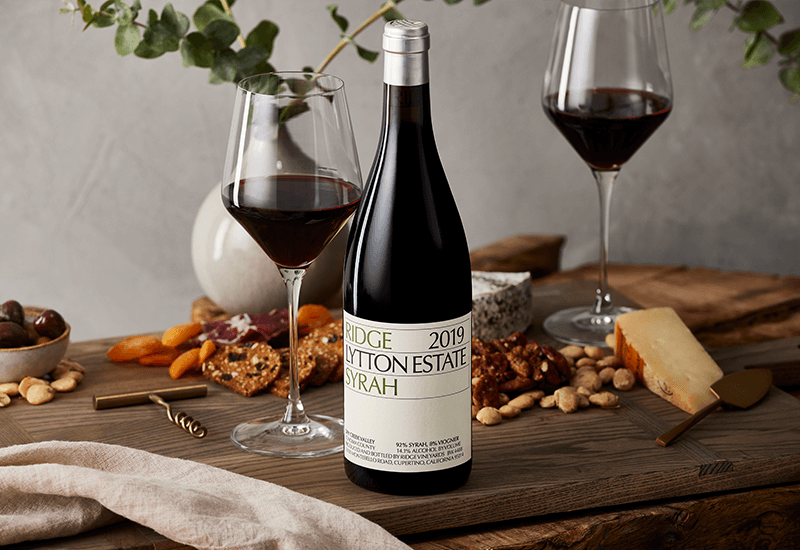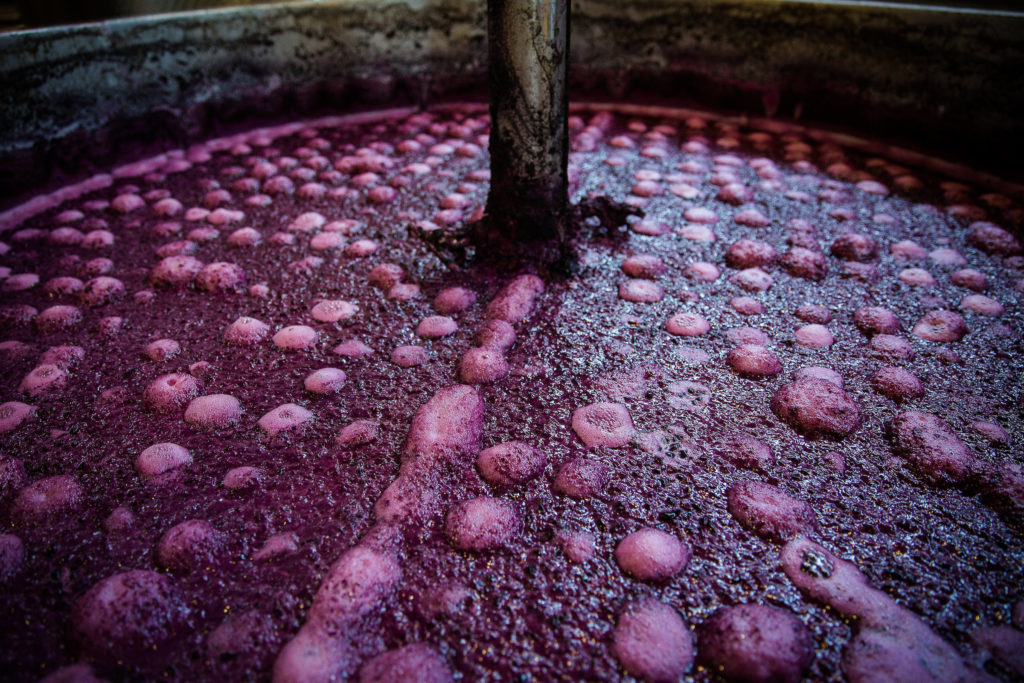Co-Fermentation of Syrah and Viognier for a Better Wine
Blog Post
Have you recently tried our Lytton Estate Syrah and want to know more about the process behind the wine? Or are you looking to learn more about co-fermentation and the other traditional wine-making processes we practice at Ridge? If so, we’ve answered all your questions in the sections below.
What is Co-Fermentation?
Co-fermentation is the winemaking process of fermenting at least two grape varieties at the same time. This traditional practice, at times connected to the winemaking process of field blends, is different from the widely used practice of blending wine components into a cuvée after fermentation.
Co-fermentation is more common for red wines than white, and Ridge highlights the benefits of this winemaking practice through the production of our Lytton Estate Syrah.

Why Co-Ferment Different Grape Varieties?
The question is, why would a winemaker co-ferment grapes rather than blending the separately fermented wines, which would allow for greater flexibility later in the process? Co-fermentation produces a handful of benefits for specific varietals, including:
- Color & Preservation
- Texture & Tannins
- Ripeness
- Aromatics
Read on for additional explanation of these benefits:
“The idea of co-fermentation isn’t new, we see greater complexity and color develop when zinfandel co-ferments with field varietals such as petite sirah, carignane, alicante bouschet, mataro etc. In the northern Rhone valley, viognier has been used in small percentages to co-ferment with syrah to aid in stabilizing the abundant color of syrah and to temper tannin extraction. This has been successfully done for hundreds of years. I would also say that viognier has a few extra weeks of ripening ahead of syrah, so in the northern Rhone valley, on a cold year, the viognier might bring ripeness to the wine.
“Now, in Dry Creek Valley, the weather is much more favorable for bringing syrah to full ripeness. The challenge for us is that the viognier can become extremely overripe by the time syrah is harvested. Fortunately, we have two small parcels of viognier that have northeast exposure to help moderate the rate of ripening so in the fermenter the brix doesn’t increase significantly.
“Chemically, there are non-pigmented phenolics within the viognier skins that have a strong affinity for bonding to side-groups of the anthocyanin pigment of syrah. Once these bonds are formed, they remain soluble and stable within the wine and provide a deep blue/purple spectrum of color. Viognier also has a beautiful pungency of apricot, peach, and white flower which helps lift the total aroma of syrah which tends to be dark and gamey.”
Details on the Co-Fermentation Process of Syrah and Viognier
Our Winemaking Team expands on the full details of the co-fermentation and winemaking process for our Lytton Estate Syrah below.
“The approach we take with co-fermentation of Syrah with Viognier, is to first de-stem the syrah and open the crusher rollers. This allows a high percentage of whole berries to travel through to fermenter uncrushed. Next, based on calculated weight, we will destem and crush anywhere between 5-10% viognier on top of the syrah in the fermenter. We then wait for natural yeast fermentation to begin, and pump-over and irrigate the cap to extract color and tannins. The typical maceration time (crush-to-press) is 7-8 days total, with twice a day pump-overs given.
“The viognier contains colorless flavanols from the skins that extract and conjugate with the extreme concentration of syrah’s anthocyanin color molecules. Basically, the theory is that viognier helps stabilize syrah’s color; the condensation reactions between viognier’s flavanols and syrah’s anthocyanins form highly stable polymerized molecules that stay with the wine for life. Once these polymers form, they don’t degrade through normal oxidation reactions.
“There is also a shift in the color spectrum of a syrah that has co-fermented with viognier. Normally, syrah has a deep ruby color. Once viognier is thrown into the mix for the complex reactions to form, the color will shift from deep ruby to saturated purple/blue. This has a lot to do with light absorption/re-emission quantum chemistry of the anthocyanin complex with the viognier flavanols altering the polarity and electron flow of the multi-six carbon phenol ring that forms the anthocyanim molecule, thus altering the molar extinction coefficient. The absorption of green spectrum light (520nm) by these condensed molecules causes re-emission of red spectrum 700nm plus a stronger re-emission at 420nm (deep purple/blue). That’s why the co-fermented syrah/viognier blend works magically, creating an inkier wine. It’s strange how this all works, taking a dark grape and cutting it with a white variety, and end up making a wine that is even darker. That’s the complexity of quantum chemistry, which I had the pleasure of studying many years ago while obtaining my biochemistry degree.
“Now, I should say that this co-fermentation phenomena has been a very traditional winemaking approach taken in the northern Rhône Valley of France. Through centuries of trial-and-error with many other varietals of the region, the combination of syrah with viognier became the standard. This was decided by making better wine, not by having knowledge of the complex chemistry. The chemistry came along much later to explain why it worked so well.”
About the Wine: 2019 Lytton Estate Syrah
At Lytton Springs West, Ridge Vineyards has just over three acres of twenty-six year-old syrah noir, the California selection from plantings in 1916, and three and a half acres of younger French clones. Over time, the consistent quality showed syrah to be well-matched to the climate and soil of Lytton Estate. As in the past, the 2019 vintage was co-fermented with a small amount of viognier from an adjacent parcel. Following harvest, it was assembled, in blind tasting, from the most intense and distinct lots.
Since 1996, we have produced limited amounts of syrah for our ATP (Advance Tasting Program) wine club. Become an ATP member today for first access to each new vintage.
Wait!
In order to qualify for user related discounts, you must log in before proceeding with checkout. Click the button below to log in and receive these benefits, or close the window to continue.
Log In